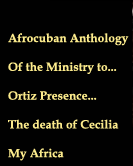




|
Del Misterio a la Esperanza (Reflexiones
en torno al culto a los Orichas en Nigeria y Cuba) by Prof. Israel Moliner Castañeda Anthropological society of the Island of Cuba For Joel James
Summary: One of the most notorious aspects in the transculturations nigero-yorubas in America is the cult to those generally low well-known mythical entities named the orishas and to who are attributed the function of acting as middlemen between the Dios Todopoderoso and the men. It is evident the existence of an abundant literature on the orishas in Nigeria, like in Cuba and Brazil, but the comparative reflections among the ways is conceive and to give learned to the same ones in the ancestral floor and in the American lands certainly are scarce. The fame of the topic and the already necessary analytic and comparative inquiry, they highly justify this study. I The establishment and later development of the culture yoruba in the Nigerian Southwest was the result of a long process that embraced near eight centuries ago. Toward half-filled of the century VIII D.C. coincide in Sierra Lioness two very important factors for the topic in question. On one hand, the Islam begins to establish progressively stronger and more continuous commercial bonds with the towns located to the South of the Sahara, arriving in first to the territories of the current states of Mauritania, Mali and Senegal, then stops later to extend to Gambia, the Guinea and Sierra Leona. Such relationships that initially were limited to the mutually beneficial exchange of merchandises, gradually they traffic toward the cultural and religious, bringing in consequence that numerous groups that professed traditional beliefs hugged the Islamism (1) . On the other hand, in an almost coincident way and maybe motivated by the same Islamic trade, the ethnos groups Mendí in Sierra Leona becomes more powerful and they begin to displace its ethnos neighbors Akú, with which had a peaceful coexistence from immemorial times. Many akús that neither were of agreement in giving up their ancestral beliefs they undertake, toward ends of the eighth century, an emigration heading for the east that takes them to be resided more or less in a extensive coast fringe that can specify among the places that today occupies the cities of I Carry Novo in Benin and Lakes in Nigeria. I sustain that such immigrants are those later known by nagós. It is very possible that a second emigration was made at the beginning of the tenth century , because it is demonstrated that its participants didn't know the work with the metals whose art gives beginning in Sierra Leona in the second half of the mentioned century. This wave penetrated more in the Nigerian southeast, settling to the west of the river Ochún in the wide territory that embraced from the coast between Lagoon and Mahín in the Southwest, while for the north they advanced toward the region of Ondo, displacing the natives Ibó a little , like one observes in the famous map made by Sanson D'Abbeville in 1656. I estimate that such akú is the acquaintances as lucumíes or ulcumíes. The third and last migration was verified D.C. in the twilights of the XII century when the akús already dominated perfectly the technique of working the metals (2). The most traditional groups united around a commander and called religious leader Oddúddúa Olofi Oyó and when not being able to be sustained in front of the mendís in Sierra Leona, they left for a very well-known route toward the west, also arriving in Nigeria, although some segments you resided and they were assimilated by diverse towns that lived in the current territories of Ghana, Togo and Benin. This group of Oddúddúa penetrated for an area to the Nigerian northwest that its predecessors, occupying territories traditionally ibó to those who defeat and they displace toward the west. This akú constitutes the initial nucleus and those later on denominated oyoes or yorubás.
|






